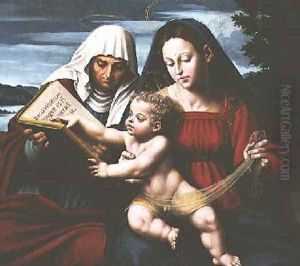Vicente Macip Paintings
Vicente Macip was a prominent Spanish painter during the Renaissance period, active mainly in the region of Valencia. Born in 1475, his life and career were deeply intertwined with the cultural and artistic developments of early 16th-century Spain. While not as widely known as some of his contemporaries, Macip played a significant role in the transition of Spanish art from the Gothic style to the Renaissance.
Macip was part of a family of artists, and his contributions to the art world were carried on by his son, Juan de Juanes, who is considered one of the most important Spanish painters of his time. This familial lineage ensured that the stylistic shifts and innovations introduced by Vicente were preserved and expanded upon in subsequent generations.
Throughout his career, Vicente Macip was known for his religious works, which were characterized by their detailed depiction of biblical scenes and figures. His paintings often reflected the humanistic ideals of the Renaissance, emphasizing the beauty and dignity of the human form within the context of religious narratives. Macip's work was marked by a mastery of light and shadow, a rich palette, and a depth of emotional expression, which helped to convey the spiritual messages of his compositions.
Macip's influence on the Valencian school of painting was profound. He helped to introduce the techniques and ideologies of the Italian Renaissance to Spain, blending them with local traditions to create works that were both innovative and deeply rooted in Spanish culture. His legacy is seen not only in the works of his son but also in the broader development of Renaissance art in Spain.
Vicente Macip died in 1545, leaving behind a body of work that, while perhaps not as extensively recognized as that of some of his peers, played a crucial role in the evolution of Spanish art. His contributions helped to lay the groundwork for the flourishing of the Spanish Renaissance and established a foundation upon which future artists could build.
